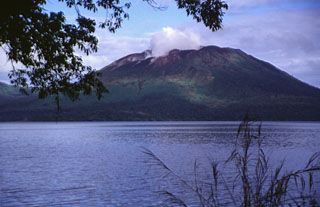Report on Gaua (Vanuatu) — 27 January-2 February 2010
Smithsonian Institution / US Geological Survey
Weekly Volcanic Activity Report, 27 January-2 February 2010
Managing Editor: Sally Sennert.
Please cite this report as:
Global Volcanism Program, 2010. Report on Gaua (Vanuatu) (Sennert, S, ed.). Weekly Volcanic Activity Report, 27 January-2 February 2010. Smithsonian Institution and US Geological Survey.
Gaua
Vanuatu
14.281°S, 167.514°E; summit elev. 729 m
All times are local (unless otherwise noted)
On 29 January, the Vanuatu Geohazards Observatory reported significant changes in Gaua's activity over the previous two weeks. They noted that since 16 January more gas was emitted and multiple explosions produced denser and darker ash plumes. During 22-29 January, the water level in the river to the E that Lake Letas feeds rose 10 cm. Gas-and-ash plumes rose 3 km and drifted S and W. On 24 January nearby villagers reported seeing ejected material from Strombolian activity. The Wellington VAAC reported that on 27 January an ash cloud was seen on satellite imagery. Strong explosions were seen and heard from East Gaua on 29 January. According to the VAAC, the Vanuatu Geohazards Observatory reported that gas-and-ash plumes rose to altitudes of 3 km (10,000 ft) a.s.l. and drifted S and W that same day.
Geological Summary. The roughly 20-km-diameter Gaua Island, also known as Santa Maria, consists of a basaltic-to-andesitic stratovolcano with an 6 x 9 km summit caldera. Small vents near the caldera rim fed Pleistocene lava flows that reached the coast on several sides of the island; littoral cones were formed where these lava flows reached the ocean. Quiet collapse that formed the roughly 700-m-deep caldera was followed by extensive ash eruptions. The active Mount Garet (or Garat) cone in the SW part of the caldera has three pit craters across the summit area. Construction of Garet and other small cinder cones has left a crescent-shaped lake. The onset of eruptive activity from a vent high on the SE flank in 1962 ended a long period of dormancy.
Sources: Wellington Volcanic Ash Advisory Center (VAAC), Vanuatu Meteorology and Geohazards Department (VMGD)

